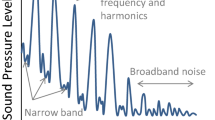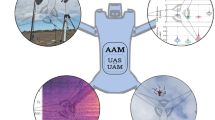Abstract
Aircraft noise remains the key inhibitor of the growth of air transportation, but the focus of the noise mitigation strategies has changed. As the propulsor fan pressure ratio is decreased for improved fuel burn and lessened environmental impact, the propulsion system noise can be reduced near or even below the noise level of the airframe. Jet noise has become less of a concern, and during approach and landing, the acoustic signature is predominantly set by the airframe. Novel aircraft concepts and architectures, enabled by distributed, more integrated, and boundary-layer ingesting propulsion systems, pose new aeroacoustic problems which require innovative approaches and call for teaming and collaboration as the technological challenges cut across disciplines. One past example of such a collaborative research effort was the Silent Aircraft Initiative (SAI), aimed at the conceptual design of an aircraft imperceptible to the human ear outside the airport perimeter. The initiative brought together researchers from academia, industry, and government agencies. This chapter gives a brief summary of the Silent Aircraft Initiative, the SAX-40 aircraft design, and the noise reduction technologies which were pursued. A decade past SAI, novel aircraft architectures such as the D8 double bubble aircraft, the outcome of a joint effort between MIT, Aurora Flight Sciences and Pratt and Whitney, are being pursued in the quest of reducing the climate impact of aviation. With regulations continuing to reduce the allowable aviation noise emission levels, both new challenges and new opportunities are emerging. Electric, hybrid, and turbo-electric aircraft concepts are currently being investigated as potential game changers. Independent of the level of electrification, noise will remain a major issue as air transportation is growing and mobility might become a key driver. The chapter discusses a selection of enabling technologies and their implications on acoustics and noise and gives a perspective on future trends and new directions in aeroacoustics required to address the challenges.






Figure adopted from [24]

Figure adopted from [29]




















Figure adapted from [48]
Similar content being viewed by others
Change history
03 April 2019
The original version of below mentioned articles was unfortunately published with the special issue title “Aircraft noise generation and assessment” as article title. The correct article titles are given below.
References
Davies, H.: Airports Commission: Final Report (2015)
Thomas, R., Burley, C., Olson, E.: Hybrid wing body aircraft system noise assessment with propulsion airframe aeroacoustic experiments. Int. J. Aeroacoust. 11(3–4), 369–409 (2012)
Manneville, A., Pilczer, D., Spakovszky, Z.: Preliminary evaluation of noise reduction approaches for a functionally silent aircraft. AIAA J. Aircr. 43(3), 836–840 (2006)
Bertsch, L., Heinze, W., Lummer, M.: Application of an aircraft design-to-noise simulation process. AIAA paper AIAA-2014-2169 (2014)
Bertsch, L., Wolters, F., Heinze, W., Pott-Pollenske, M., Blinstrub, J.: System noise assessment of a tube-and-wing aircraft with geared turbofan engines. AIAA paper AIAA-2018-0264 (2018)
Dowling, A., Greitzer, E.: The silent aircraft initiative—overview. AIAA paper AIAA-2007-0452 (2007)
Hileman, J., Spakovszky, Z., Drela, M., Sargeant, M.: Airframe design for silent fuel-efficient aircraft. AIAA J. 47(3), 956–969 (2010)
Toyota Prius Specifications, Toyota Motor Sales, U.S.A., Torrance, CA (2005). http://www.toyota.com/prius/specs.html. Accessed 2018
Hall, C., Schwartz, E., Hileman, J.: Assessment of technologies for the silent aircraft initiative. AIAA J. Propul. Power 25(6), 1153–1162 (2009)
Hileman, J., Reynolds, T., de la Rosa Blanco, E., Law, T., Thomas, S.: Development of approach procedures for silent aircraft. AIAA paper AIAA-2007-0451 (2007)
Sargeant, M., Hynes, T., Graham, W., Hileman, J., Drela, M., Spakovszky, Z.: Stability of hybrid-wing-body-type aircraft with centerbody leading-edge carving. AIAA J. Aircr. 47(3), 970–974 (2010)
Herr, M., Dobrzynski, W.: Experimental investigations in low noise trailing edge design AIAA paper AIAA-2004-2804 (2004)
Quayle, A., Dowling, A., Babinsky, H., Shin, H.-C., Graham, W., Sijtsma, P.: Landing gear for a silent aircraft. AIAA paper AIAA-2007-0231 (2007)
Khorrami, M., Humphreys, W., Lockard, D., Ravetta, P.: Aeroacoustic evaluation of flap and landing gear noise reduction concepts. AIAA paper AIAA-2014-2478 (2014)
Sakaliyski, K., Hileman, J., Spakovszky, Z.: Aero-acoustics of perforated drag plates for quiet transport aircraft. AIAA paper AIAA-2007-1032 (2007)
Shah, P., Pfeiffer, G., David, R., Hartley, T., Spakovszky, Z.: Full-scale turbofan demonstration of a deployable engine air-brake for drag management applications. ASME Turbo Expo Paper GT2016-56708 (2016)
Drela, M.: Power balance in aerodynamics flows. AIAA J. 47(7), 1761–1771 (2009)
Law, T., Dowling, A.: Optimisation of annular and cylindrical liners for mixed exhaust aeroengines. AIAA paper AIAA 2007–3546 (2007)
Defoe, J., Spakovszky, Z.: Effects of boundary-layer ingestion on the aero-acoustics of transonic fan rotors. ASME J. Turbomach. 135, 051013 (2013)
de la Rosa Banco, E., Hall, C., Crichton, D.: Challenges in the silent aircraft engine design. AIAA paper AIAA 2007–454 (2007)
Agarwal, A., Dowling, A.: Low-frequency acoustic shielding by the silent aircraft airframe. AIAA J. 45(2), 358–365 (2007)
Ng, L., Spakovszky, Z.: Noise shielding assessment of hybrid wing-body aircraft configurations. AIAA J. 49(11), 2444–2452 (2011)
Crichton, D., de la Rosa Blanco, E., Hileman, J.: Design and operation for ultra low noise take-off. AIAA paper AIAA-2007-0456 (2007)
Heath, S., Brooks, T., Hutcheson, F., Doty, M., Bahr, C., Hoad, D., Becker, L., Humphrey, W., Burley, C., Stead, D., Pope, D., Spalt, T., Kuchta, D., Plassman, G., Moen, J.: NASA hybrid wing aircraft aeroacoustic test documentation report. NASA TM-2016-219185 (2016)
Hutcheson, F., Brooks, T., Burley, C., Bahr, C., Stead, D., Pope, D.: Shielding of turbomachinery broadband noise by a hybrid wing body aircraft configuration. AIAA paper AIAA-2014-2624 (2014)
Doty, M., Brooks, T., Burley, C., Bahr, C., Pope, D.: Jet noise shielding provided by a hybrid wing body aircraft. AIAA paper AIAA-2014-2625 (2014)
Thomas, R., Burley, C., Nickol, C.: Assessment of the noise reduction potential of advanced subsonic transport concepts for the NASA environmentally responsible aviation project. AIAA paper AIAA-2016-0863 (2016)
Drela, M.: Development of the D8 transport configuration. AIAA paper AIAA-2011-3970 (2011)
Uranga, A., Drela, M., Greitzer, E., Hall, D., Titchener, N., Lieu, M., Siu, N., Casses, C., Huang, A., Gatlin, G., Hannon, J.: Boundary layer ingestion benefit of the D8 transport aircraft. AIAA J. 55(11), 3693–3708 (2017)
de la Rosa Blanco, E., Hileman, J.: Noise assessment of the double-bubble aircraft configuration. AIAA paper AIAA-2011-268 (2011)
Yutko, B., Titchener, N., Courtin, C., Lieu, M., Wirsing, L., Tylko, J., Chambers, J., Roberts, T., Church, C.: Conceptual design of a D8 commercial aircraft. AIAA paper AIAA-2017-3590 (2017)
Lopes, L., Burley, C.: ANOPP2 User Manual. NASA TM-2016-219342 (2016)
Beranek, L.: Noise and Vibration Control, pp. 174–180. McGraw-Hill Book Company, New York (1971)
Maekawa, Z.: Noise reduction by screens. J. Appl. Acoust. 1, 157–173 (1968)
Nark, D., Burley, C., Tinetti, A., Rawls, J.: Initial integration of noise prediction tools for acoustic scattering effects. AIAA paper AIAA-2008-2996 (2008)
Colas, D., Spakovszky, Z.: A Turbomachinery noise shielding framework based on the modified theory of physical optics. AIAA paper AIAA-2013-2136 (2013)
Colas, D.: A diffraction integral based turbomachinery noise shielding method. Master’s Thesis, Department of Aeronautics & Astronautics, MIT ( 2011)
Kumar, P.Sunil, Ranganath, G.: Geometrical theory of diffraction. J. Phys. 3(6), 457–488 (1991)
Nark, D., Envia, E., Burley, C.: Fan noise prediction with applications to aircraft system noise assessment. AIAA paper AIAA-2009-3291
Wang, Z., Wu, S.: Helmholtz equation least-squares method for reconstructing the acoustic pressure field. J. Acoust. Soc. Am. 192(4), 2020–2032 (1997)
Tinetti, A., Dunn, M.: Aeroacoustic noise prediction using the fast scattering code. AIAA paper AIAA-2005-3061 (2005)
Peters, A., Spakovszky, Z., Lord, W., Rose, B.: Ultrashort nacelles for low fan pressure ratio propulsors. ASME J. Turbomach. 137, 021001 (2015)
Gallagher, K., Goebel, S., Greszler, T., Mathias, M., Oelerich, W., Erogluab, D., Srinivasana, V.: Quantifying the promise of lithium-air batteries for electric vehicles. Energy Environ. Sci. 7, 1555 (2014)
Defoe, J., Narkaj, A., Spakovszky, Z.: A body-force-based method for prediction of multiple-pure-tone noise: validation. AIAA paper AIAA-2010-3747 (2010)
Podboy, G., Krupar, M., Helland, S., Hughes, C.: Steady and unsteady flow field measurements within a NASA 22 inch fan model. AIAA paper AIAA-2002-1033 (2002)
Hughes, C., Jeracki, R., Woodward, R., Miller, C.: Fan noise source diagnostic test: rotor alone aerodynamic performance results. AIAA paper AIAA-2002-2426 (2002)
Defoe, J., Spakovszky, Z.: Shock propagation and MPT noise from a transonic rotor in nonuniform flow. ASME J. Turbomach. 135, 011016 (2013)
Lord, W., Suciu, G., Hasel, K., Chandler, J.: Engine architecture for high efficiency at small core size. AIAA paper AIAA-2015-0071 (2015)
Acknowledgements
The work described in this chapter has resulted from contributions of a number of individuals, many of whom are co-authors of the referenced papers. In particular I would like to express my sincere thanks to Dame Ann Dowling at Cambridge University and Edward Greitzer at MIT, the two leads of the Silent Aircraft Project, to James Hileman, my co-Chief Engineer on the project, and to all the students, post-docs, researchers, and industry collaborators involved. The research described in this chapter was funded by the Cambridge-MIT Institute (CMI), NASA Langley Research Center, and the National Institute of Aerospace (NIA). This support is gratefully acknowledged.
Author information
Authors and Affiliations
Corresponding author
Additional information
This chapter is dedicated to my late father Sándor Lajos Ignác Spakovszky who first opened my eyes to the beauty of engineering and ever since instilled in me the passion that comes with it.
Publisher’s Note
Springer Nature remains neutral with regard to jurisdictional claims in published maps and institutional affiliations.
The original version of this article has been revised because the title of the special issue was accidentally displayed as the article title.
This paper is part of a Special Issue on Aircraft Noise Generation and Assessment.
Rights and permissions
About this article
Cite this article
Spakovszky, Z.S. Advanced low-noise aircraft configurations and their assessment: past, present, and future. CEAS Aeronaut J 10, 137–157 (2019). https://doi.org/10.1007/s13272-019-00371-8
Received:
Revised:
Accepted:
Published:
Issue Date:
DOI: https://doi.org/10.1007/s13272-019-00371-8




